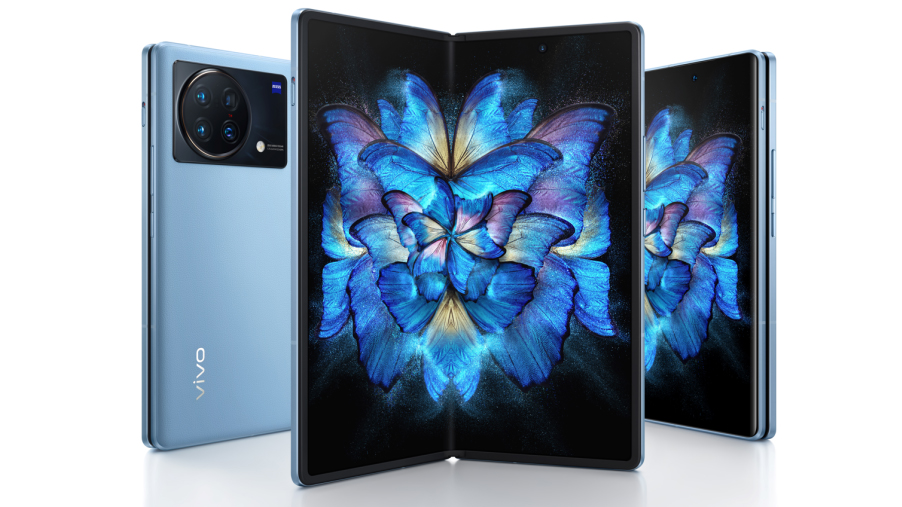Samsung Galaxy Z Fold 4 needs to steal these two big features
Here's what Samsung can learn from the Vivo X Fold

We're excited for the Samsung Galaxy Z Fold 4 but it's got a few things to learn about fingerprint sensors and display creases from a new foldable rival from China.
The Vivo X Fold, the first foldable from the Chinese phone maker, offers dual fingerprint sensors and virtually no crease in the inner display, fixing two popular gripes with the foldable phone format. While there's no sign of the Vivo foldable leaving China, these features — plus its reasonable starting price of 8,999 yuan (around $1,400) — could cause problems for Samsung's current domination of the best foldable phones.
Under-display fingerprint readers are everywhere on regular smartphones, but we've yet to see a foldable with one. These have in the past opted for power button-mounted sensors that you can easily access from the side of the foldable whether it's open or closed. What the Vivo X Fold does though is use two scanners: one in the center the outside display and one on the right portion of the inner display.
It should in theory offer the same ease of access for users as a capacitive power button sensor. The sensors are top quality components too, using the same ultrasonic scanning method that the Samsung Galaxy S22 family uses for improved reliability and speed over standard optical scanners.
Meanwhile, the crease in the X Fold's display also seems to be minimal compared to the whacking great line down the center of the Samsung Galaxy Z Fold 3. Vivo seems to have achieved a perfectly smooth display by using a gentler, waterdrop-shaped, cavity in the hinge for the display to fit into, plus a "floating mid-plate" that slides into place as the fold opens to smooth out any marking. Samsung would be wise to adopt this type of hinge for its own foldables, both the Z Fold 4 and the smaller Galaxy Z Flip 4.
Vivo X Fold: other features
While the Z Fold 3 does pack a decent triple-camera array on the back, Vivo's gone another step by offering its very best photo tech on the X Fold. It has four rear cameras: a 50MP main camera, a 48MP ultrawide camera, a 12MP portrait camera and an 8MP 5x optical telephoto camera. This quarter of cameras are all treated with a Zeiss T* lens coating for improved anti-glare performance. There are also two 16MP selfie cameras embedded on the inner and outer screens.
While these two features are definitely the highlights, there are other good parts to the X Fold. It uses a Snapdragon 8 Gen 1 chipset with 12GB RAM, and offers 66W wired charging and 50W wireless charging. You even get an 80W dual-port charging brick in the box, so you can charge the foldable and a second device at the same time.
Sign up to get the BEST of Tom's Guide direct to your inbox.
Get instant access to breaking news, the hottest reviews, great deals and helpful tips.
The displays consist of a 6.5-inch external display and an 8-inch internal display, both with 120Hz max refresh rates (although only the inside display has an adaptive refresh rate). The inner display and hinge are rated for 300,000 folds, which Vivo claims should mean the folding mechanism lasts an average user for 10 years.
The aspect ratio of the Vivo is different from the Z Fold 3, with the X Fold being wider but shorter, which should make using the outer display more practical. It's a heavy beast though, weighing 10.9 ounces (311 grams), almost an ounce and a half (42 grams) more than the Z Fold 3.
While Vivo isn't a big name in the U.K. and doesn't sell its products at all in the U.S., we may still see this tech on more familiar brands. Vivo is part of the same BBK Electronics group as Oppo and OnePlus, two brands that readers are likely much more familiar with. Oppo already gave us the Oppo Find N, and OnePlus was recently rumored to be adapting that model for its own debut foldable. So new foldables from both brands are likely in the near future, which we hope will borrow a feature or two from this great-sounding Vivo foldable.
The Galaxy Z Fold 4 on the other hand is thought to be a modest update to the already strong Z Fold 3. It could gain a 108MP main camera (same as the Galaxy S22 Ultra), but it will apparently keep the side fingerprint-scanning power button.

Richard is based in London, covering news, reviews and how-tos for phones, tablets, gaming, and whatever else people need advice on. Following on from his MA in Magazine Journalism at the University of Sheffield, he's also written for WIRED U.K., The Register and Creative Bloq. When not at work, he's likely thinking about how to brew the perfect cup of specialty coffee.
